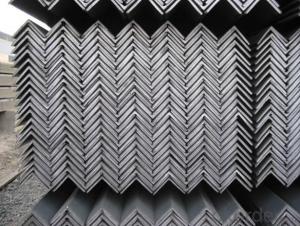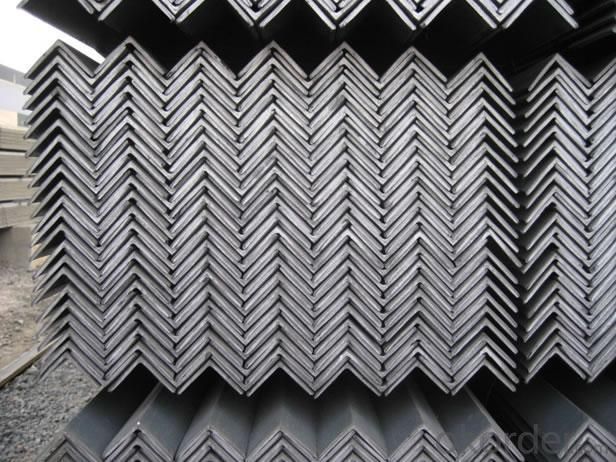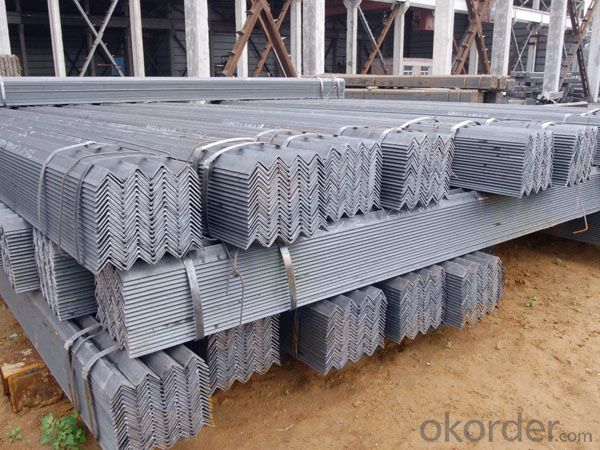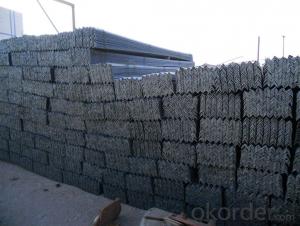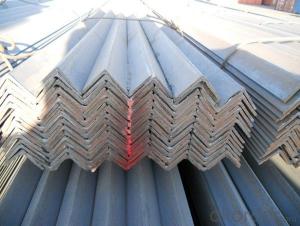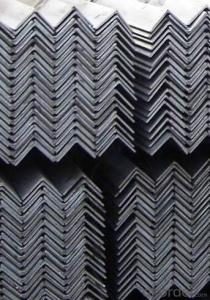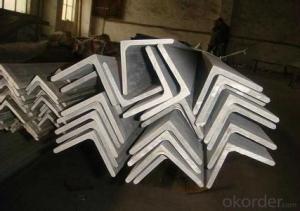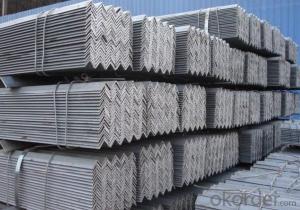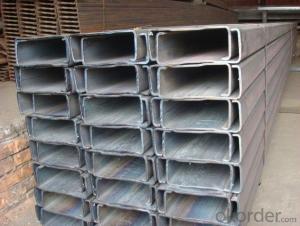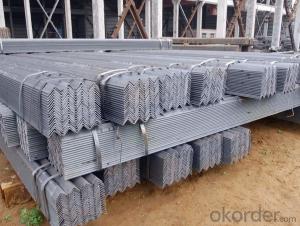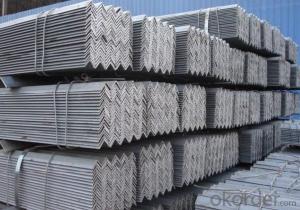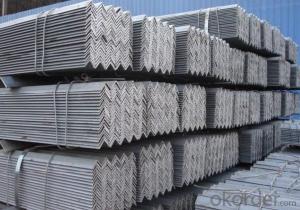ANGLE STEEL 20MM
- Loading Port:
- China Main Port
- Payment Terms:
- TT OR LC
- Min Order Qty:
- -
- Supply Capability:
- -
OKorder Service Pledge
OKorder Financial Service
You Might Also Like
Angle Steel Details:
| Minimum Order Quantity: | 25mtons | Unit: | m.t. | Loading Port: | China Main Port |
| Supply Ability: | 80000-100000MTS/YEAR | Payment Terms: | TT or LC |
Product Description:
Specifications of Angle Steel
1. Invoicing on theoretical weight or actual weight as customer request
2. Length: 6m, 9m, 12m as following table
3. Sizes

Sizes: 25mm-250mm | ||
a*t | ||
25*2.5-4.0 | 70*6.0-9.0 | 130*9.0-15 |
30*2.5-6.6 | 75*6.0-9.0 | 140*10-14 |
36*3.0-5.0 | 80*5.0-10 | 150*10-20 |
38*2.3-6.0 | 90*7.0-10 | 160*10-16 |
40*3.0-5.0 | 100*6.0-12 | 175*12-15 |
45*4.0-6.0 | 110*8.0-10 | 180*12-18 |
50*4.0-6.0 | 120*6.0-15 | 200*14-25 |
60*4.0-8.0 | 125*8.0-14 | 250*25 |
5. Payment terms:
1).100% irrevocable L/C at sight.
2).30% T/T prepaid and the balance against the copy of B/L.
3).30% T/T prepaid and the balance against L/C
6.Material details:
Alloy No | Grade | Element (%) | | ||||
C | Mn | S | P | Si | | ||
| | |||||||
|
|
|
|
|
|
| |
Q235 | B | 0.12—0.20 | 0.3—0.7 | ≤0.045 | ≤0.045 | ≤0.3 | |
|
|
|
|
|
|
| |
Alloy No | Grade | Yielding strength point( Mpa) | | ||||
Thickness (mm) | | ||||||
≤16 | >16--40 | >40--60 | >60--100 | | |||
≥ | | ||||||
|
|
|
|
|
| | |
Q235 | B | 235 | 225 | 215 | 205 | | |
Alloy No | Grade | Tensile strength (Mpa) | Elongation after fracture (%) | | |||
Thickness (mm) | | ||||||
| ≤16 | >16--40 | >40--60 | >60--100 | | ||
≥ | | ||||||
|
|
|
|
|
|
| |
Q235 | B | 375--500 | 26 | 25 | 24 | 23 | |
Usage & Applications of Angle Steel
According to the needs of different structures, Angle can compose to different force support component, and also can be the connections between components. It is widely used in various building structures and engineering structures such as roof beams, bridges, transmission towers, hoisting machinery and transport machinery, ships, industrial furnaces, reaction tower, container frame and warehouse etc.
Packaging & Delivery of Angle Steel
1. Packing: it is nude packed in bundles by steel wire rod
2. Bundle weight: not more than 3.5MT for bulk vessel; less than 3 MT for container load
3. Marks:
Color marking: There will be color marking on both end of the bundle for the cargo delivered by bulk vessel. That makes it easily to distinguish at the destination port.
Tag mark: there will be tag mark tied up on the bundles. The information usually including supplier logo and name, product name, made in China, shipping marks and other information request by the customer.
If loading by container the marking is not needed, but we will prepare it as customer request.
Production flow of Angle Steel
Material prepare (billet) —heat up—rough rolling—precision rolling—cooling—packing—storage and transportation
- Q: How do you connect steel angles together?
- Steel angles can be connected together by various methods such as welding, bolting, or using steel angle brackets.
- Q: How do you prevent steel angles from sagging?
- To prevent steel angles from sagging, there are several measures that can be taken: 1. Proper design: Ensure that the steel angles are designed and sized correctly for the load they will bear. This involves considering the span length, the applied load, and the material strength. Consulting with a structural engineer can help determine the appropriate size and thickness of the steel angles. 2. Adequate support: Provide sufficient support for the steel angles at regular intervals along their length. This can be achieved by using intermediate supports such as columns, beams, or braces. The spacing of these supports should be determined based on the load and the properties of the steel angles. 3. Reinforcement: Depending on the load requirements, additional reinforcements can be added to the steel angles. This can include stiffeners, gussets, or flanges to increase their load-carrying capacity and resistance to sagging. 4. Quality fabrication: Ensure that the steel angles are fabricated to meet industry standards and specifications. This includes proper welding techniques, accurate cutting, and appropriate surface preparation to avoid any weak points or defects that may contribute to sagging. 5. Regular inspection and maintenance: Regularly inspect the steel angles to identify any signs of sagging or structural issues. This can involve visual inspections, measurements, and non-destructive testing methods. Promptly address any identified problems to prevent further deformation and ensure the long-term integrity of the steel angles. By following these preventive measures, steel angles can be effectively protected against sagging and maintain their structural stability over time.
- Q: Can steel angles be used in pedestrian bridges?
- Yes, steel angles can be used in the construction of pedestrian bridges. Steel angles are commonly used in bridge construction due to their high strength-to-weight ratio and versatility. They are often used as structural members to provide support, stability, and rigidity to the bridge structure. Steel angles are capable of withstanding heavy loads and forces, making them suitable for pedestrian bridges that need to support the weight of individuals walking across. Additionally, steel angles can be easily fabricated and welded, allowing for flexibility in the design and construction of pedestrian bridges. Overall, steel angles are a popular choice for constructing pedestrian bridges due to their durability, strength, and ease of use.
- Q: What are the different testing methods for steel angles?
- There are several testing methods for steel angles, including visual inspection, dimensional measurement, hardness testing, chemical analysis, and mechanical testing. Visual inspection involves examining the angles for any visual defects or irregularities. Dimensional measurement ensures that the angles meet the specified size and shape requirements. Hardness testing determines the hardness of the steel, which is an important factor in its strength and durability. Chemical analysis is performed to check the composition and purity of the steel, ensuring that it meets the required standards. Mechanical testing involves subjecting the steel angles to various loads and stresses to evaluate their mechanical properties such as strength and ductility.
- Q: Can steel angles be used in high-temperature applications?
- Steel angles can be used in high-temperature applications depending on the specific alloy and the temperature range. Steel alloys that have been specifically designed for high-temperature applications, such as stainless steels or heat-resistant alloys, can withstand elevated temperatures without significant loss in strength or structural integrity. These alloys often contain elements like chromium, nickel, or molybdenum, which increase their resistance to corrosion, oxidation, and high temperatures. However, it is important to note that not all steel angles are suitable for high-temperature applications. Ordinary carbon steels, for example, have a limited temperature range before they start to lose strength and become susceptible to deformation or failure. The exact temperature limit for a specific steel angle will depend on factors such as the alloy composition, heat treatment, and the duration of exposure to high temperatures. In summary, steel angles can be used in high-temperature applications if they are made from appropriate alloys that are specifically designed for such conditions. It is crucial to consult with materials engineers or experts who can provide guidance on the suitable steel alloys and temperature limits for a given application to ensure safe and reliable performance.
- Q: How do steel angles perform in high-pressure applications?
- Steel angles perform well in high-pressure applications due to their high strength and rigidity. They are capable of withstanding the immense pressure and maintaining their structural integrity, making them a reliable choice for such applications.
- Q: How do you determine the load-bearing capacity of a steel angle?
- In order to ascertain the load-bearing capacity of a steel angle, several considerations must be made. Initially, the material properties of the steel angle need to be known, including its yield strength and ultimate tensile strength. These values can be acquired from the manufacturer or relevant material standards. Subsequently, the dimensions and shape of the steel angle play a crucial role in determining its load-bearing capacity. Precise measurements of the angle's thickness, width, and length are necessary. Additionally, the angle's shape, whether it is equal or unequal, must also be taken into account. Once these properties are established, the load-bearing capacity can be calculated utilizing engineering principles and structural analysis methods. One common approach involves the use of Euler's formula, which considers the bending and axial loads on the steel angle. Euler's formula states that the load-bearing capacity of a steel angle is proportionate to its moment of inertia and the modulus of elasticity. These values are calculated based on the angle's dimensions and shape. Moreover, other factors such as the angle's end supports, the type of loading (e.g., concentrated load or uniformly distributed load), and any additional safety factors must be considered. It is important to note that determining the load-bearing capacity of a steel angle is a complex process that requires expertise in structural engineering. Therefore, it is advisable to seek consultation from a qualified engineer or refer to relevant design codes and standards to ensure accurate and safe calculations.
- Q: What are the different types of connections used for steel angles in educational institutions?
- Steel angles in educational institutions can be connected using various methods. These connections play a crucial role in joining steel angles together for different applications and structural configurations. Here are some commonly used types of connections: 1. Welded Connections: Educational institutions often rely on welding to connect steel angles. This method involves melting and fusing the steel angles together using heat, resulting in a strong and durable connection. Welded connections are ideal for structural applications that require high strength and rigidity. 2. Bolted Connections: Another popular method is using bolts, nuts, and washers to secure steel angles. This type of connection allows for easy disassembly and reassembly, making it suitable for applications that require flexibility and adjustability. Non-structural applications like furniture, handrails, and brackets commonly employ bolted connections. 3. Riveted Connections: Riveting, an older connection method, involves joining steel angles using rivets. Rivets are inserted through pre-drilled holes in the angles and then hammered or compressed to secure the connection. Although less commonly used today, some older structures within educational institutions still employ riveted connections. 4. Clip Connections: Specially designed clips or brackets can be used to connect steel angles in clip connections. These clips are typically bolted or welded to the angles, providing a quick and efficient connection method. Clip connections find applications in areas where easy installation and maintenance are important, such as suspended ceilings or modular structures. 5. Gusset Plate Connections: Gusset plate connections utilize additional steel plates (gusset plates) to connect steel angles. These gusset plates are usually welded or bolted to the angles, enhancing the strength and stability of the connection. Heavy-duty structural applications like trusses or frames in educational institutions commonly employ gusset plate connections. The selection of the appropriate connection type for steel angles in educational institutions depends on factors such as load requirements, structural design, ease of installation, and maintenance considerations. It is crucial to consult with structural engineers and adhere to relevant building codes and regulations to ensure the usage of safe and suitable connections.
- Q: How are steel angles protected against corrosion?
- There are various techniques available to protect steel angles from corrosion. One commonly used method entails applying a protective coating. This can be accomplished by either painting the steel angles with a paint that resists corrosion or by employing galvanization, which involves immersing the steel angles in molten zinc to create a protective layer on the surface. Another approach to prevent corrosion in steel angles is the application of a corrosion inhibitor. This involves introducing chemicals or compounds to the steel angles that impede or decelerate the corrosion process. Additionally, conducting regular inspections and performing proper maintenance can aid in detecting and addressing any indications of corrosion before they result in significant damage.
- Q: Double angle steel rod in the corners of the roof steel why need to set the plate?
- Double angle truss rod set in which plate in the corners between the steel is mainly to increase its stiffness.
Send your message to us
ANGLE STEEL 20MM
- Loading Port:
- China Main Port
- Payment Terms:
- TT OR LC
- Min Order Qty:
- -
- Supply Capability:
- -
OKorder Service Pledge
OKorder Financial Service
Similar products
Hot products
Hot Searches
Related keywords
